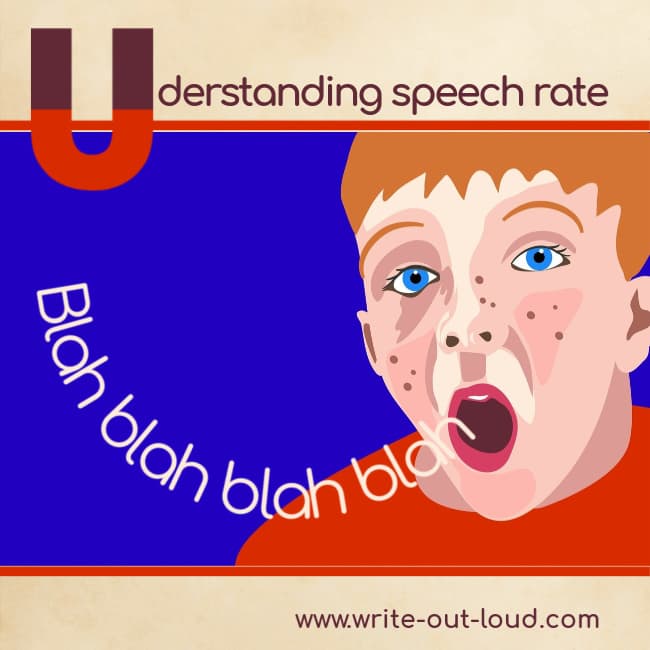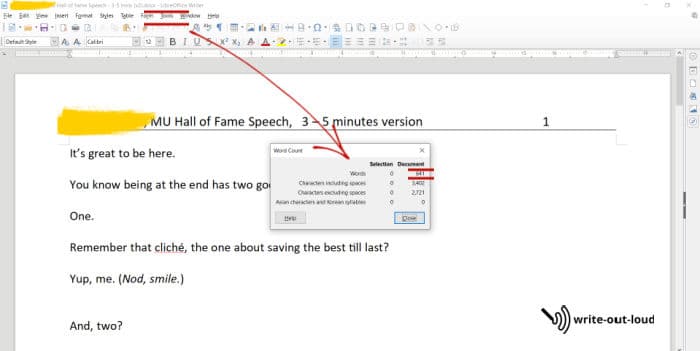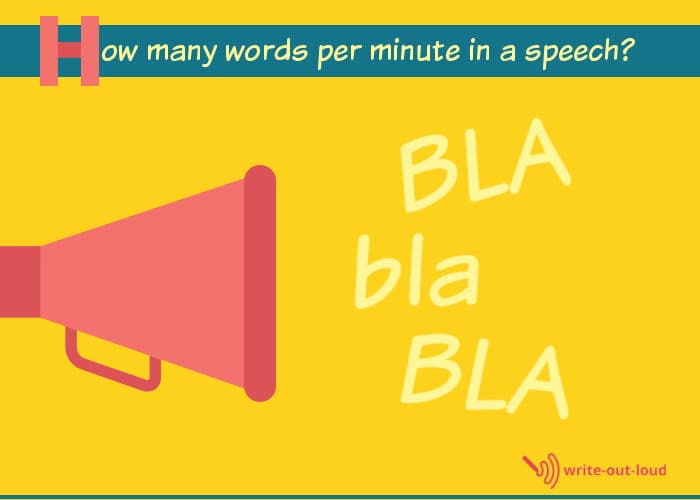- Games, topic printables & more
- The 4 main speech types
- Example speeches
- Commemorative
- Declamation
- Demonstration
- Informative
- Introduction
- Student Council
- Speech topics
- Poems to read aloud
- How to write a speech
- Using props/visual aids
- Acute anxiety help
- Breathing exercises
- Letting go - free e-course
- Using self-hypnosis
- Delivery overview
- 4 modes of delivery
- How to make cue cards
- How to read a speech
- 9 vocal aspects
- Vocal variety
- Diction/articulation
- Pronunciation
- Speaking rate
- How to use pauses
- Eye contact
- Body language
- Voice image
- Voice health
- Public speaking activities and games
- Blogging Aloud
- About me/contact
- Speech delivery
- Speech rate

What's your speech rate?
Why a flexible speaking rate is important.
By: Susan Dugdale
Is your speech rate too fast, too slow, or just right?
And what is, a normal speaking pace?
The answers to both questions are not straight forward. They fall into the 'it depends' category. And what they're depending on is context.
Context is everything when it comes to deciding whether the speed you speak at is good, extremely good, or poor.
What you'll find on this page
- why, and when, speech rate becomes important
- what speech rate is and how it is calculated
- 2 ways of finding out your own speech rate
- speech rate guidelines - what's fast or slow?
- reasons to change your speech rate
- exercises to develop a flexible speaking rate
- a link to a free printable: a diagnostic resource used by speech therapists to test speech fluency and rate, The Rainbow Passage
- a link to a quick reference guide: how many words per minute are in 1 through to 10 minute speeches .
- links to authoritative references for more information
Why, and when, is speech rate important?
Speech rate – how fast, or how slowly a person talks, only becomes important when the speed of their speech becomes a barrier to effective communication.
If people listening are not able to fully take in or comprehend what is being said and a large part of the reason for that is speech rate, then it's time to take action.

What is speech rate? How is it calculated?
Speech rate refers to a person's habitual speaking speed. It's calculated through counting the normal number of words they say per minute, and just like people, words per minute (wpm) can vary hugely.
Additionally, because all words are not equal, wpm can only ever be an approximate measure. For instance, a word can be as simple as a single syllable like "it" or a single letter like “I”, or a collection of many syllables such as “hippopotamus” or “tintinnabulation” - the ringing of bells.
One syllable is considerably quicker to say than many, just as a simple short sentence is faster to say than a complex longer one.
How to work out your own speech rate
Here are two ways of working out your habitual speech rate.
The first is to read aloud The Rainbow Passage. This piece of text is frequently used by speech language therapists as a diagnostic tool to test a person's ability to produce connected speech .
Record yourself as you read it aloud at your regular speaking rate for one minute.
How far you get through the passage will give you an indication * of your rate of speech.
Here are the first 175 words. The entire piece has 330 words.
(There's a printable pdf of the whole Rainbow Passage for you to download at the bottom of the page.)
The Rainbow Passage
When the sunlight strikes raindrops in the air, they act as a prism and form a rainbow. The rainbow is a division of white light into many beautiful colors. These take the shape of a long round arch, with its path high above, and its two ends apparently beyond the horizon. (51 words)
There is, according to legend, a boiling pot of gold at one end. People look, but no one ever finds it. When a man looks for something beyond his reach, his friends say he is looking for the pot of gold at the end of the rainbow. (99 words)
Throughout the centuries people have explained the rainbow in various ways. Some have accepted it as a miracle without physical explanation. To the Hebrews it was a token that there would be no more universal floods. The Greeks used to imagine that it was a sign from the gods to foretell war or heavy rain. The Norsemen considered the rainbow as a bridge over which the gods passed from earth to their home in the sky. (175 words)
* I've used the word 'indication' because you are reading aloud rather than giving a speech or talking to a friend. There is a difference.
You'll also need to take into account your familiarity with the text. A 'cold' reading, that is reading the passage without seeing it before hand will probably influence how much of it you get through in a minute.
Record yourself delivering a speech
The second way to test yourself is to record one of your own speeches or presentations. This will give you a much more accurate measure of your actual speech rate.
If you have the text of your speech in a word document you'll have access under the Tools tab (see image below) to the total word count.

Record the speech. Then take the time you took to deliver it and use it to divide the number of words.
To give you an example I recorded the 'Hall of Fame' speech I wrote for a client a couple of years ago. I took 4.9 minutes to say it through. The total word count of the speech is 641.
Therefore, 641 words divided by 4.9 minutes = a speaking rate of 130 words per minute.
Speech rate guidelines
Studies show speech rate alters depending on the speaker's culture, geographical location, subject matter, choice of vocabulary and its usage (simple short sentences v complex), fluency, use of pauses, gender, age, emotional state, health, profession, audience, and whether or not they're using their primary, or native, language.
However, despite these variables, there are widely accepted guidelines. These are:
- Slow speech is usually regarded as less than 110 wpm, or words per minute.
- Conversational speech generally falls between 120 wpm at the slow end, to 160 - 200 wpm in the fast range.
- People who read books for radio or podcasts are often asked to speak at 150-160 wpm.
- Auctioneers or commentators who practice speed speech are usually in the 250 to 400 wpm range.
Why change your speech rate?
Generally people are not conscious of their habitual speaking speed and if they are easily understood by those listening to them there is little reason to change. Their speech could be considered too slow or too fast by people outside of their normal environment but if they are not routinely communicating with them it doesn't really matter.
However changes of audience and speech purpose can force a need to become more aware of speaking speed.
For example - a shift from one part of a country to another, from a slower speaking area to a faster speaking one, will, through audience response, make a habitually slower speaker aware of their speech rate.
Similarly someone with naturally fast speech who takes a job requiring presentations to colleagues or customers, will find themselves having to slow down in order to communicate effectively.
Having an accent makes a difference too. If the language you're using is not your first one there may be pronunciation issues which make it harder for your audience to understand you. Slowing down your rate of speech will help.
Public speaking and rate of speech
If you're giving a speech or presentation, the concept of a normal speaking speed doesn't apply.
What does is flexibility - the ability of the speaker to mix and match pace appropriately with speech content and the audience's ability to comprehend it.
Experience and audience reaction will teach you that a one-size-fits-all approach will be far less effective than careful variation in rate.
Exercises to change speaking rate
If you know you speak either too fast, too slowly or without speed variation then exercises to develop flexibility are what you need.
Here are Quick and Easy Effective Tips for Speaking Rate Flexibility
These six exercises specifically address the undesirable audience responses brought on by a speaker either talking too quickly or too slowly. Have fun with them!
How many words per minute in a speech?

When you have a speech to give with a strict time limit it's useful to have an estimate of how many words will fit comfortably into the time allocated, before you begin to write.
For more see: How many words per minute in a speech: a quick reference guide for 1 through to 10 minute speeches.

Do you know what your voice says about you?
Find out about Voice Image First impressions count and they're not only about looking good, but sounding good too!
References and additional information
Miller, N., Maruyama, G., Beaber, R. J., & Valone, K. (1976). Speed of speech and persuasion . Journal of Personality and Social Psychology, 34(4), 615–624.
Smith, S. M., & Shaffer, D. R. (1991). Celerity and cajolery: Rapid speech may promote or inhibit persuasion through its impact on message elaboration . Personality and Social Psychology Bulletin, 17(6), 663–669.
Rodero, E. (2012). A comparative analysis of speech rate and perception in radio bulletins . Text & Talk, 32 (3), pp. 391–411
Apple, W., Streeter, L.A., & Krauss, R. M. (1979). Effects of Pitch and Speech Rate on Personal Attributions . Journal of Personality and Social Psychology, 37( 5), 715-727
Optimal Podcast Words per Minute Rate for Biggest Impact - an extremely thorough article by Chris Land of improvepodcast.com
What is the ideal rate of speech? Public speaking coach Lynda Stucky 'shows and tells' about speech rate. She's made 7 variations of The Rainbow Passage so that you can hear the difference speed makes.
Speech Pace: do you talk too fast or too slow? Take this test . - a YouTube video by speech teacher Laura Bergells.
Perfect Your Speed Talking at This Auction School - a YouTube video showing how The Missouri Auction School teaches speed speech. ☺
Download The Rainbow Passage
Click the link to download a printable pdf of The Rainbow Passage .
- Return to top of speech rate page
speaking out loud
Subscribe for FREE weekly alerts about what's new For more see speaking out loud

Top 10 popular pages
- Welcome speech
- Demonstration speech topics
- Impromptu speech topic cards
- Thank you quotes
- Impromptu public speaking topics
- Farewell speeches
- Phrases for welcome speeches
- Student council speeches
- Free sample eulogies
From fear to fun in 28 ways
A complete one stop resource to scuttle fear in the best of all possible ways - with laughter.

Useful pages
- Search this site
- About me & Contact
- Free e-course
- Privacy policy
©Copyright 2006-24 www.write-out-loud.com
Designed and built by Clickstream Designs
All Subjects
Advanced Public Speaking
Study guides for every class, that actually explain what's on your next test, from class:.
Pace refers to the speed at which a speaker delivers their message. It plays a crucial role in how an audience perceives and processes information, influencing engagement and comprehension. A well-managed pace can enhance the effectiveness of a speech by allowing time for emphasis and reflection while preventing monotony or confusion.
congrats on reading the definition of Pace . now let's actually learn it.
5 Must Know Facts For Your Next Test
- A slower pace can create suspense and emphasize important points, while a faster pace can convey excitement and urgency.
- Variations in pace throughout a speech can help maintain audience interest and highlight key messages.
- The ideal pace may vary depending on the complexity of the content; more complex information often requires a slower delivery for better understanding.
- Pauses are an important tool that can be used within pacing to give the audience time to absorb information or react to emotional moments.
- Cultural factors can influence perceptions of pace, so understanding your audience is key to effective delivery.
Review Questions
- Changing your pace can significantly enhance audience engagement and comprehension by creating contrast in the delivery. A slower pace allows listeners to absorb complex information or reflect on key points, while a faster pace can build excitement and keep energy levels high. Using variations in pace strategically helps to maintain interest throughout the speech and ensure that the audience is both engaged and informed.
- Pace works hand-in-hand with tone and pitch to create an impactful presentation. For example, when a speaker uses a slower pace with a warm tone, it can evoke feelings of trust and connection with the audience. Conversely, using a quickened pace combined with an excited pitch can generate enthusiasm. The combination of these vocal techniques shapes how the message is received, ensuring that different sections of the speech resonate effectively.
- Cultural differences can greatly influence perceptions of pacing in public speaking. In some cultures, a rapid delivery might be seen as enthusiastic and engaging, while in others it could be perceived as rushed or disrespectful. Understanding these cultural nuances is crucial for speakers aiming to connect with diverse audiences. By adjusting their pacing based on cultural expectations, speakers can improve their effectiveness and ensure that their messages are communicated clearly and respectfully.
Related terms
Tempo : Tempo describes the overall speed of a performance or delivery, similar to pace but often applied to music and broader contexts.
Cadence is the rhythmic flow of a sequence of sounds or words, affecting how pace is perceived through patterns of rise and fall in speech.
Delivery : Delivery encompasses all aspects of how a speaker presents their speech, including pace, tone, volume, and body language.
" Pace " also found in:
Subjects ( 10 ).
- AP English Literature
- Acting for the Stage
- Documentary Forms
- English and Language Arts Education
- Fundamentals of Stage Directing
- Introduction to Communication Behavior
- Introduction to Public Speaking
- Professional Presentation
- Speech and Debate
- Stage Management
© 2024 Fiveable Inc. All rights reserved.
Ap® and sat® are trademarks registered by the college board, which is not affiliated with, and does not endorse this website..

IMAGES